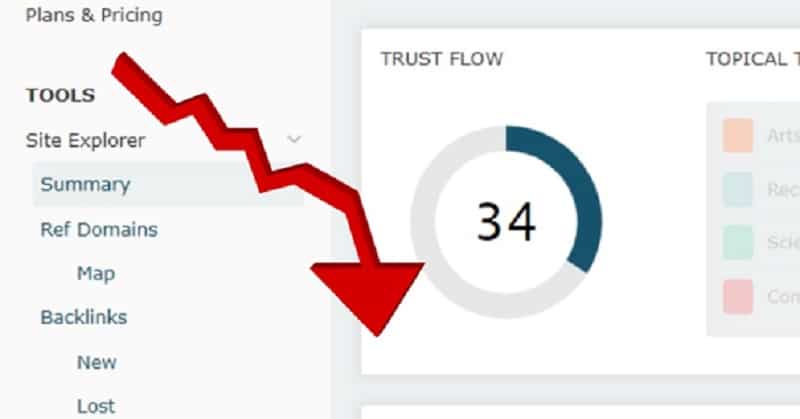Trust Flow is a crucial metric in online marketing and SEO, reflecting the credibility and authority of a website. However, there are instances where Trust Flow may experience a decline, impacting the site’s overall performance. If you’ve been wondering “why my trust flow dropped?” we will explore its reasons and discuss effective strategies to restore it. By understanding the causes and implementing the right tactics, you can reclaim and even enhance your website’s Trust Flow.
Why my Trust Flow dropped: Top 3 reasons behind declining TF
When your Trust Flow decreases, it can negatively impact your organic rankings and overall website visibility. Understanding the reasons behind the decline of your Trust Flow is the first step towards restoring it. Let’s explore some of the common causes:
- Low-quality backlinks: One of the main reasons for a decline in Trust Flow is the presence of low-quality backlinks. These are links from spammy or irrelevant websites with little authority. Search engines consider these links a red flag and may penalize your website, resulting in a drop in trust flow.
- Penalties from search engines: Search engine penalties, such as Google’s algorithm updates or manual penalties, can significantly impact your Trust Flow. These penalties are usually imposed when a website violates search engine guidelines, such as engaging in manipulative link-building practices or having thin, low-quality content.
- Lack of relevant and authoritative content: Another factor that can contribute to a decline in Trust Flow is the absence of relevant and authoritative content on your website. When your content fails to provide value to your audience or lacks expertise, it can negatively affect your website’s credibility and Trust Flow.
The impact of declining Trust Flow on website rankings
 A decline in Trust Flow can have far-reaching consequences for your website’s organic rankings. Here’s how it can impact your website:
A decline in Trust Flow can have far-reaching consequences for your website’s organic rankings. Here’s how it can impact your website:
- Decreased visibility in search results: When your Trust Flow decreases, search engines may perceive your website as less trustworthy and authoritative. As a result, your website may appear lower in search engine results pages (SERPs), leading to reduced visibility and organic traffic.
- Negative impact on domain authority: Trust Flow is closely tied to domain authority. When your Trust Flow declines, it can harm your overall domain authority, making it harder to rank for competitive keywords and attract high-quality backlinks.
- Loss of customer trust: Trust is a crucial factor for online success. If your website’s Trust Flow declines, it can erode the trust and confidence of your audience. This can decrease conversions, customer loyalty, and overall business growth.
Effective strategies to regain Trust Flow
Now that you have a clear understanding of the reasons behind the decline of your Trust Flow let’s discuss effective strategies to regain it and restore your website’s credibility:
- Backlink Audit and Cleanup: Conduct a thorough audit of your backlink profile. Identify and disavow toxic or spammy links using tools like Google Disavow. Focus on acquiring high-quality, relevant backlinks from authoritative sources to rebuild Trust Flow.
- Content Refresh and Expansion: Regularly update existing content and expand your website with new, valuable content. This improves user experience and signals to search engines that your site is current and relevant.
- Responsive Design and Mobile Optimization: In the era of mobile browsing, having a responsive and mobile-friendly website is crucial. Optimize your site for various devices to enhance user experience, indirectly contributing to improved Trust Flow.
- Enhanced Site Security: Invest in robust security measures for your website, including SSL certificates and other security protocols. A secure site protects user data and contributes to higher trustworthiness in the eyes of search engines.
- Social Proof and User Reviews: Encourage positive user reviews and testimonials. Showcase social proof on your website to establish credibility. Positive user feedback contributes to a positive perception, potentially influencing Trust Flow.
Understanding why your Trust Flow dropped is the first step toward recovery. By addressing issues related to backlinks, content quality, algorithm updates, site security, and user trust, you can implement effective strategies to restore and enhance your website’s Trust Flow. Stay proactive, stay informed, and consistently work towards building a trustworthy online presence.
So, as you can see, link-building is a critical factor in boosting your Trust Flow. Outreach Bee can assist you in achieving this through manual link building. Our strategies stay current with Google’s algorithms for optimal results. Contact us for more information.
FAQs
Q: How is Trust Flow calculated?
A: Trust Flow is calculated by analyzing the quality of backlinks to a website. It considers the credibility of the linking domains and the overall link profile of a site.
Q: How to check Trust Flow?
A: To check Trust Flow, you can use online tools such as Majestic, Ahrefs, or Moz. Simply enter the URL of the website you want to analyze, and these tools will provide you with the Trust Flow score along with other relevant metrics.
Q: What is the scale of Trust Flow?
A: Trust Flow is measured on a scale from 0 to 100. Higher scores indicate a more trustworthy and authoritative website.
Q: Can Trust Flow be manipulated?
A: Attempting to manipulate Trust Flow through artificial or spammy link-building practices is not recommended. Search engines are becoming more sophisticated in detecting such manipulations, which can lead to penalties.
Q: Does Trust Flow affect search engine rankings?
A: While Trust Flow is not a direct ranking factor, it can indicate a website’s overall authority and trustworthiness. Websites with higher Trust Flow scores may have a better chance of ranking well in search engine results.



What is a DNS, and Why Do You Need One?
In Need of a Good VPN? Here is a List Based on Reliability, Speed, and Security